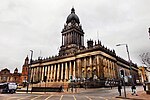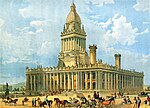Leeds School of Medicine

The School of Medicine is the medical school of the University of Leeds, in the city of Leeds, West Yorkshire, England. The School of Medicine was founded in 1831. The School of Medicine now forms part of the University's Faculty of Medicine and Health. The School is composed of institutes located at multiple sites in West Yorkshire including the Worsley Building, LIGHT, St James's Campus, and Chapel Allerton Hospital. The School of Medicine is primarily linked with two major hospitals for clinical teaching: the Leeds General Infirmary and St James's University Hospital, both run by the Leeds Teaching Hospitals NHS Trust, alongside smaller district NHS Trusts.
Excerpt from the Wikipedia article Leeds School of Medicine (License: CC BY-SA 3.0, Authors, Images).Leeds School of Medicine
Great George Street, Leeds Woodhouse
Geographical coordinates (GPS) Address Nearby Places Show on map
Geographical coordinates (GPS)
| Latitude | Longitude |
|---|---|
| N 53.801 ° | E -1.552 ° |
Address
Grain
Great George Street
LS1 3BY Leeds, Woodhouse
England, United Kingdom
Open on Google Maps










